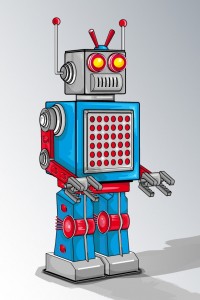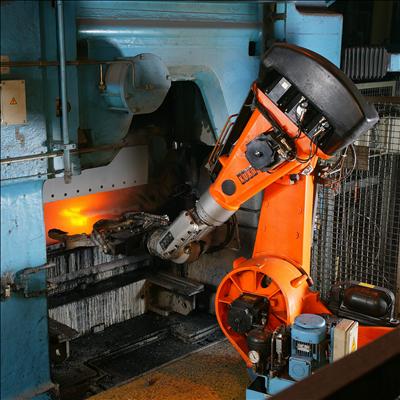Robots
 When I was growing up one of my favorite shows on TV was the Jetsons. There were cool looking houses, flying cars that folded up into a suitcase and best of all, robots! Then Star Wars came out in the 1970s and C3PO and R2-D2 reinforced my image of what robots were like.
When I was growing up one of my favorite shows on TV was the Jetsons. There were cool looking houses, flying cars that folded up into a suitcase and best of all, robots! Then Star Wars came out in the 1970s and C3PO and R2-D2 reinforced my image of what robots were like.
As I got involved with automation a different picture emerged. Where were the faces, mechanical voices and beeps and clicks? The first robot I worked on was a five axis robot that applied glue to a glove pattern. It certainly didn’t look like Rosie the Jetson’s maid or even the Lost In Space Robot B-9.

Industrial robots are used extensively for palletizing and packaging of manufactured goods, welding, assembly and moving heavy objects. The job may be boring, such as domestic cleaning, or dangerous, such as exploring inside a volcano. Other jobs are physically inaccessible, such as exploring another planet, cleaning the inside of a long pipe, or performing laparoscopic surgery.
Most robots today are programmable using a variety of techniques including ladder logic, structured text or standard computer programming languages. The controller may be a dedicated board level controller or a PC based system. Libraries of points and moves are often used for organization and are often “taught” using a pendant controller. A variety of coordinate systems may be used depending on the application including “world”, cartesian, polar, cylindrical or referenced to a specific axis. Typical industrial robots are 4-7 axes of movement and mounted to a base.
There are also a variety of physical configurations for robots such as SCARA, Articulated Arm or Gantry. The SCARA acronym stands for Selective Compliant Assembly Robot Arm. It’s also sometimes referred to as a Selective Compliant Articulated Robot Arm.In general, traditional SCARA’s are 4-axis robot arms, i.e., they can move to any X-Y-Z coordinate within their work envelope. There is a fourth axis of motion which is the wrist rotate (Theta-Z).
Articulated robots or robotic arms typically have 6-7 axes of movement starting at the base and ending with the grippers. Not only can they move to almost any point within their work envelope, they can also approach that point from any orientation. Most of the robots seen in automotive factories doing assembly and welding are the articulated arm type.
Gantry type robots start with an X-Y-Z configuration but unlike a SCARA are mounted to a framework rather than being mounted on a central base. They are typically lower cost and easier to manufacture out of standard off-the-shelf products but are less flexible and take up more space.
A great resource for general information on the different types of robots and their applications is the “All On Robots” website and blog. Not only do they cover industrial robots but also military, medical and even household robots like Rosie!
